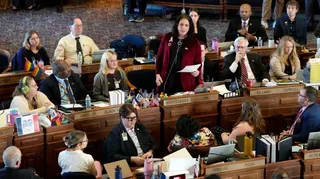July 7, 2020
Medicare Nursing Home COVID Site Leaves Users 'In the Dark'
Ricardo Alonso-Zaldivar READ TIME: 3 MIN.
When the Trump administration required nursing homes to report their COVID-19 cases, it also promised to make the data available to residents, families and the public in a user-friendly way.
But some facilities that have had coronavirus cases and deaths turn up as having none on Medicare's COVID-19 nursing home website. Those data may be incomplete because the reporting requirements don't reach back to the start of the pandemic. Numbers don't necessarily portray the full picture.
"The biggest thing that needs to be taken away ... is in its current form, it is really leaving consumers in the dark," Sam Brooks, project manager for Consumer Voice, said of Medicare's data website. Consumer Voice is a national advocacy group for improved quality in long-term care.
Nursing homes are only required to provide the government with data on coronavirus cases and deaths among residents and staff as of May 8, or more than two months after the first outbreak in a U.S. facility was reported. Nursing homes have the option of full disclosure, but not all have taken it, and there is no penalty for withholding older data that may reflect poorly.
The missing information from early in the pandemic leads to some puzzling results on the website.
For example, a nursing home that had one of the first major reported outbreaks in the country – Life Care Center of Kirkland, Washington – shows no confirmed COVID cases and no deaths on the CMS data page.
A spokesman for Life Care Centers of America, a major chain, said the company is providing the information the government requested.
"We are reporting what CMS is asking us to report to them," said Tim Killian. "We are not evading them in any way.
"The Kirkland facility is now COVID-free and it has been for some time," Killian added. The data showing no cases "is a snapshot of what is currently in the facility."
The company said its cumulative count shows 100 residents tested positive, and 34 died. "You can ask us directly and we'll give you the exact numbers," said Killian.
But consumer advocate Brooks said that information should be on the CMS site.
As it stands, the site "doesn't tell the whole picture," he said. "You are not going to be able to look at a home and make an informed decision."
The federal Centers for Medicare and Medicaid Services, which sets standards for nursing homes, said protecting nursing home residents is a top priority, and "transparency and information sharing has proven to be one of the keys to the battle against this pandemic."
But CMS said it lacked the legal authority to require nursing homes to disclose COVID information from before the effective date of its reporting rule in May.
On Capitol Hill, there is pressure for more information.
Sen. Chuck Grassley, R-Iowa, recently introduced legislation that would require nursing homes to report coronavirus cases and deaths going back to Jan. 1, a push that has bipartisan support.
The estimated 1.4 million people living in some 15,500 nursing homes represent a tiny share of the U.S. population, but they have borne a disproportionate share of coronavirus deaths. Nursing homes are only now starting to emerge from a national lockdown that took effect in mid-March.
According to the latest CMS figures, more than 33,000 nursing home residents have died in the pandemic. A running tally by The Associated Press, which also includes other long-term care facilities and staff as well as residents, shows more than 55,000 deaths.
Depending on the total count, that translates from about one-fourth of the deaths to more than 40%, strikingly high proportions in either case.
Coronavirus data for nursing homes do not appear directly on Medicare's NursingHomeCompare website, the main portal for consumers trying to research a facility on behalf of a family member or friend. Instead, a link takes users to a different COVID-19 site that features statistics and a national nursing home locator map.
Finding information on individual nursing homes via the data website can be confusing.
If users type in a ZIP code or the name of a nursing home, the website's locator map will display some small red dots near a larger marker icon, which also has a big dot in the middle.
Instructions say click on one of the dots. But which one?
The data is under the small red dots, not the larger locator, which instinctively draws the user's eye.
"I would click on the big dot," said policy attorney Toby Edelman of the Center for Medicare Advocacy, which represents enrollees. "Why would I look for this thing that I can barely see?"
CMS said it has received no reports related to search problems although more than 100,000 individuals accessed the site in June.
The agency says it will continue to evaluate the usability of the website to ensure it meets consumer needs.







